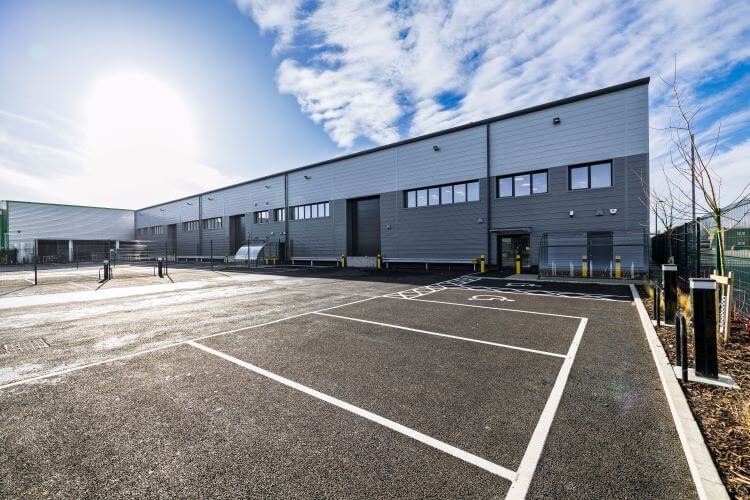
8 April, 2025
New Waltham Abbey Industrial Estate Changes Hands
Learn more
18 October, 2024 · 3 min read
Although we are now some way from the boom of the immediate post-Covid years, industrial & logistics remains extremely popular with investors globally. The reasons are obvious: continued (if slower) growth in e-commerce; the importance of logistics networks to retailer competitiveness; and perhaps most saliently, the need for greater inventories, and more domestic supply chains, to protect against the growing threat of geopolitical disruption. The strength of demand across geographies and different types of stock provides a sharp contrast with sectors such as offices and retail.
Naturally, this logic applies in the UK too. Industrial transactions accounted for 26% of the entire market over the 12 months to the end of June this year. Just four years ago that stood at 14%.
Admittedly, UK vacancy rates have crept upwards in recent years. Take-up, while remaining robust by historic standards, has fallen back over the past 18 months as economic pressures have impacted occupiers. Perhaps more importantly, development begun during the boom has come to the market. This should not be exaggerated, though – in London it has moved from around 4% to circa 6% over a two-year period; a slower rise, and a much lower overall level of empty stock, than in most other sectors.
Meanwhile, the economic picture has started to look rosier as GDP figures have become positive. Inflation – which has had dramatic effects on the consumer – has now fallen to 1.7%, taking it below the official target for the first time since 2021. Retail sales volumes are now showing sustained growth, a very different picture from the vertiginous fall of 2022 and the flatlining of 2023. Falling rates and debt costs will increase the attractiveness of the sector for investors. Overall, while it is unlikely that there will be a return to the activity of a few years ago, the scene is being set for a sustained increase in demand for logistics space.
This demand for large warehouses – ‘big sheds’ – in the Midlands and other regions can be easily met over time, given the significant pipeline of consented sites. Rising appetite among occupiers and investors for ‘mid box’ or ‘small box’ units of under 100,000 sq ft is more difficult to address. It is particularly problematic in London where space is generally at a premium. Indeed, according to the Greater London Authority, the amount of land in the capital in industrial use fell from 20,465 acres in 2001 to 16,800 in 2020, a reduction of 16% or 3,665 acres. Most of this has been developed for residential use, given the huge demand (and price) of housing, and the understandable emphasis placed by planners upon dealing with the housing crisis.
With residential values falling in London in the wake of the Covid-19 epidemic – and industrial spiking as logistics became the essential property sector – it was not unusual to see logistics developers outbidding residential for sites. Indeed, the higher level of vacancy seen over the past year or so is directly attributable to that period, and it may also explain the lower levels of new housing seen in London over the past year or so.
This process is now reversing, but the impacts will not be apparent for another year at least.
Industrial capital values saw very rapid corrections after the interest rate shocks of 2022 – in London, for example, they have fallen by 27% over the past two years. Residential, in the meantime, has seen a revival; despite spiking interest rates, prices did not fall as much as many expected and with the easing in mortgage rates over the past few months they are now rising. As a result, over the same
period, residential capital values fell by just 3%-5%, depending on which index you look at. As a result, housing is now, more often than not, outcompeting industrial for sites once again.
This is not the only alternative use that is crowding logistics out; the demand – and stratospheric prices paid – for data centres (where energy infrastructure permits) is also affecting the market. One recent example is Royal London’s sale of a consented 33.6-acre residential site in Southall to a data centre operator. This is, of course, not the only reason why industrial development has slowed – market fundamentals and construction and debt costs also play a role. But it is surely one factor.
The planning policy background is also not particularly supportive of industrial development. For some years now, planning policy documents have been focussed on housing. The recent draft revision of the National Planning Policy Framework (NPPF) has very little directed at supporting industrial, logistics or warehousing growth.
Given the scale and importance of the housing crisis, this is perhaps understandable; but if our cities grow, and our economy is to thrive, we also need places to produce, store and distribute goods. This is a particular issue in London, given space constraints, the historic loss of industrial land, and the competition among uses.
By this time next year, industrial vacancy will be declining while rents and investor activity will be on the rise. The market will be on the verge of another logistics boom – but without the product to drive it, with implications for London’s economy as well as its property market. Greater confidence among developers and investors will help, but without more support in planning policy, supply in the form of new development could be very scarce indeed.
Montagu Evans’ full report, London Industrial & Logistics, State of the Market 2024, can be found here: https://www.montagu-evans.co.uk/research/montagu-evans-presents-london-industrial-logistics-state-of-the-market-report/

3 April, 2025
by Tim Hayns, Robert Lawson
Learn more

13 March, 2025
by Oli Pye
Learn more

12 March, 2025
by Jon Neale
Learn more